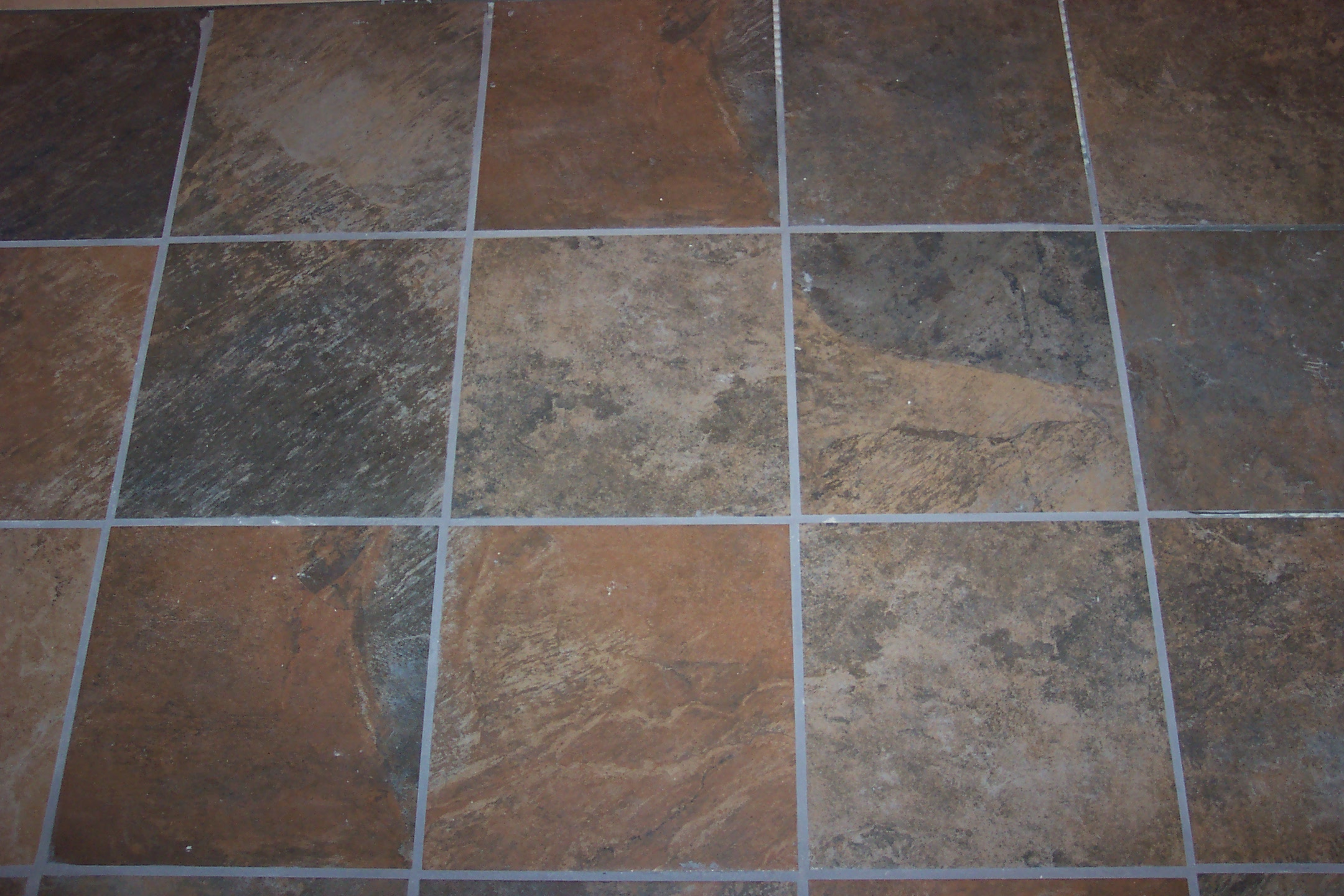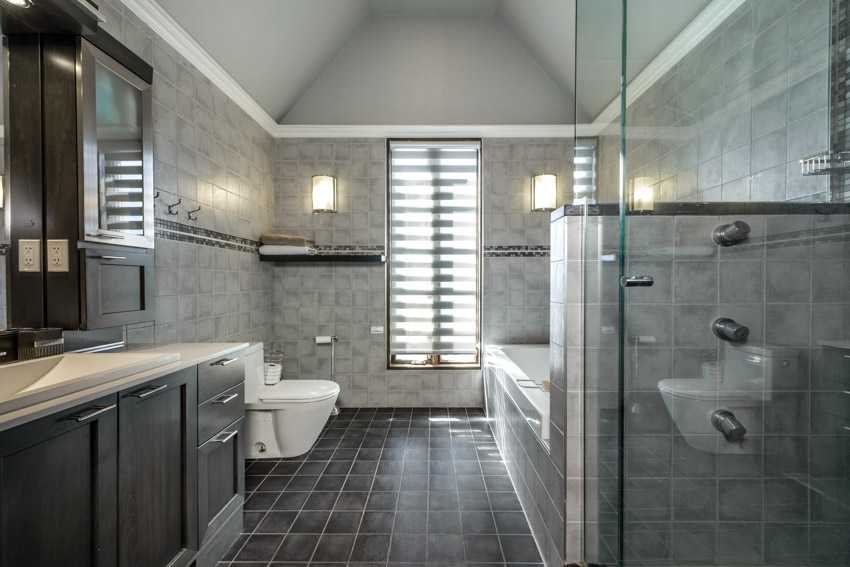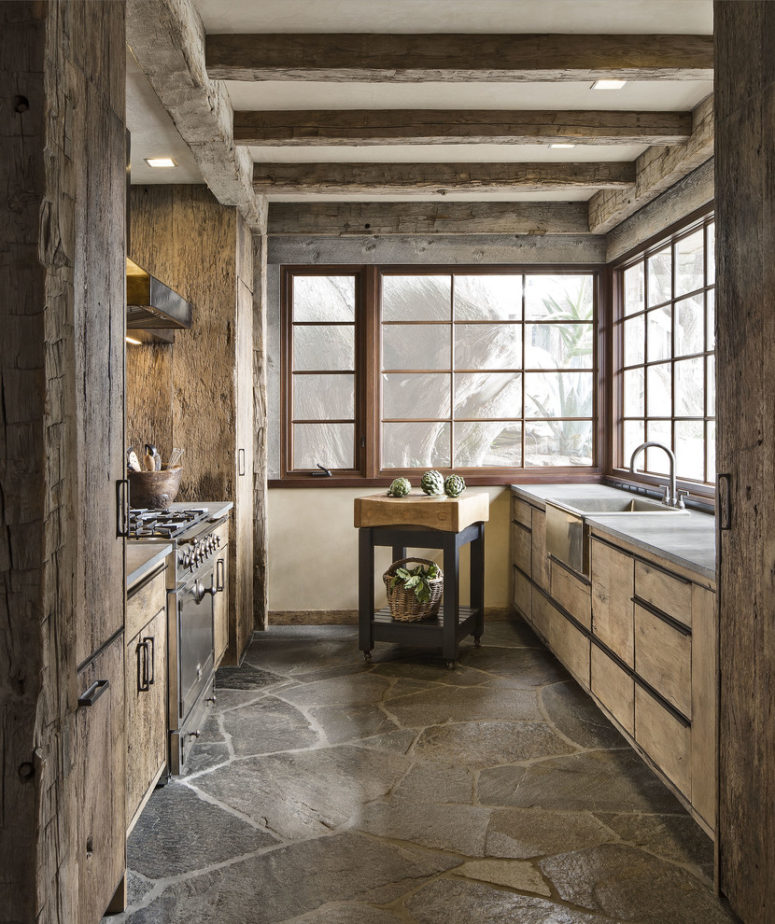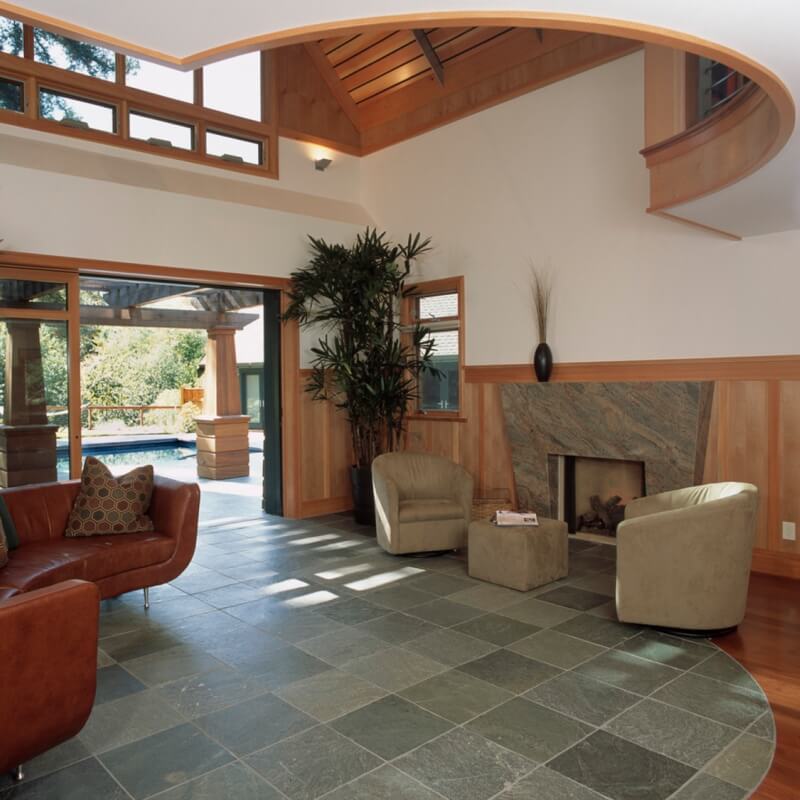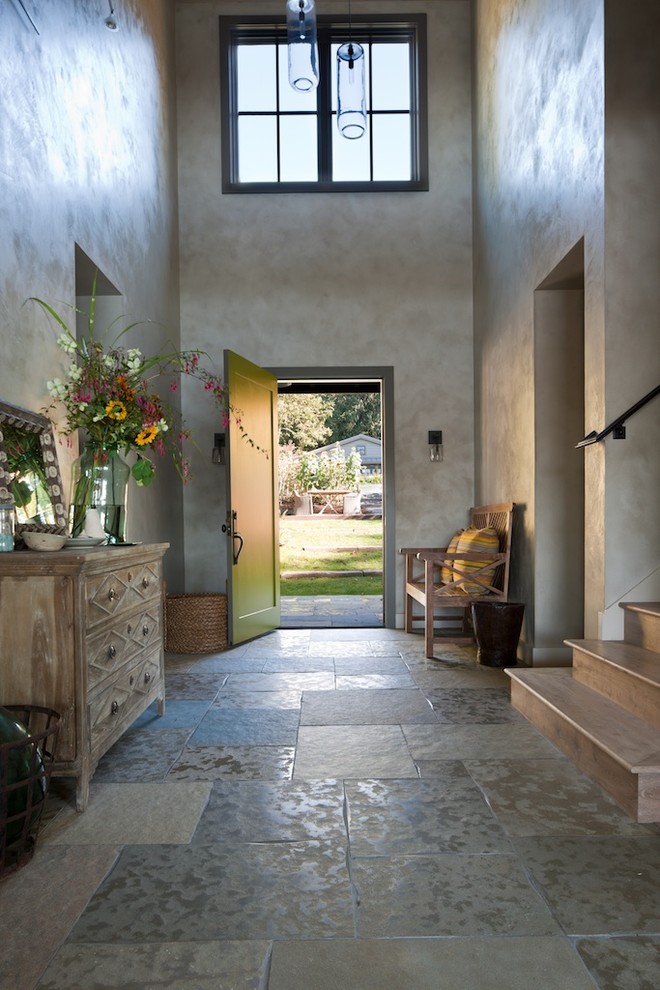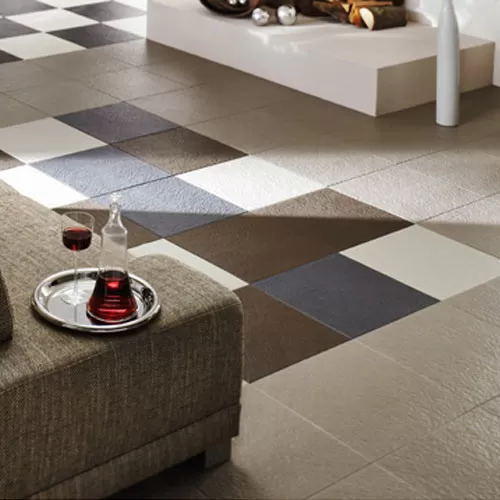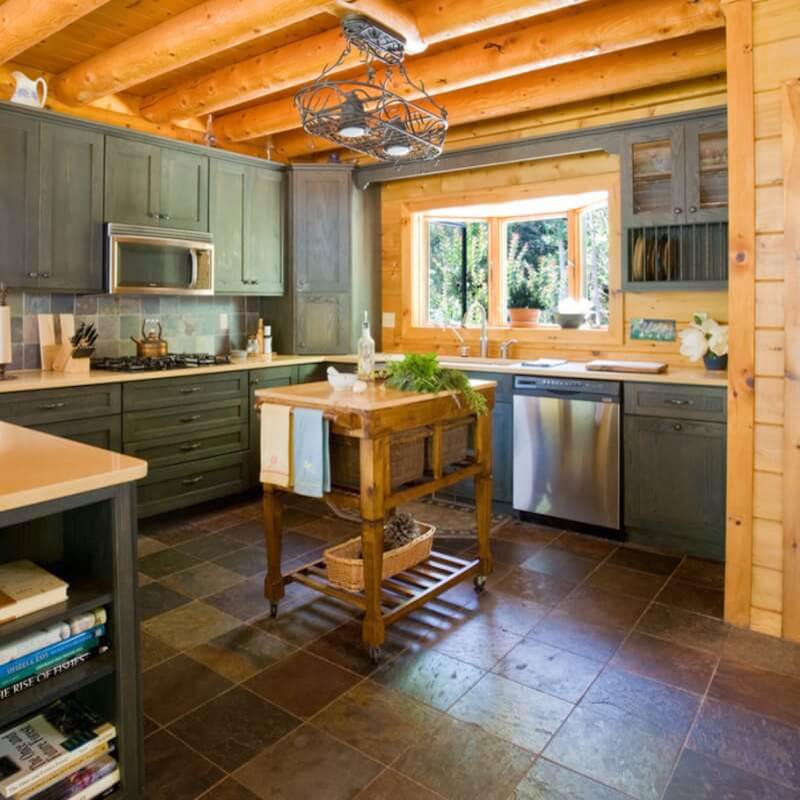The Benefits of Slate Tile Flooring
Slate tile flooring offers a unique blend of beauty and practicality that makes it a popular choice for homeowners seeking a natural, sophisticated look. Here’s an in-depth look at the benefits that make slate flooring a desirable option.
- Durability and Longevity
One of the standout features of slate tile is its impressive durability. As a metamorphic rock, slate is formed under high pressure and temperature, making it exceptionally hard and resistant to wear. Slate floors can handle heavy foot traffic without showing significant signs of wear, making them ideal for high-traffic areas like entryways, kitchens, and hallways. With proper care, slate flooring can last for decades, offering excellent long-term value. - Water and Stain Resistance
Slate tiles are naturally resistant to water and stains, which is especially beneficial in areas prone to moisture, like bathrooms and kitchens. When sealed properly, slate becomes even more impervious to liquids, preventing water damage and reducing the risk of staining from spills. This characteristic also makes slate flooring a great option for outdoor areas, as it can withstand various weather conditions without deteriorating. - Slip Resistance
Slate has a naturally textured surface that provides excellent traction, reducing the likelihood of slips and falls. This makes slate an ideal choice for homes with children or elderly individuals who may benefit from a safer, non-slip surface. Slate tiles are available in a range of finishes, some of which provide more grip than others, allowing homeowners to choose the best option for their needs. - Aesthetic Versatility
The beauty of slate lies in its natural variation in color and texture. No two slate tiles are identical, which adds a unique, organic feel to any room. Slate’s earthy tones—ranging from deep grays and blues to warm browns and greens—can complement both modern and traditional aesthetics, offering a timeless appeal that suits a variety of interior styles. - Eco-Friendly Option
As a natural stone, slate is an environmentally friendly choice for flooring. Slate is sustainably sourced from quarries, and its durability means it won’t need to be replaced as often as other flooring materials, reducing the demand for new resources. Homeowners looking for eco-friendly materials will appreciate slate’s minimal environmental impact. - Boosts Home Value
Installing slate tile flooring can increase a home’s value due to its quality and longevity. Slate is often viewed as a high-end material, and potential buyers recognize it as a durable, beautiful addition to any home. By investing in slate flooring, homeowners may see a positive return when it’s time to sell their property.

Exploring Different Styles of Slate Tile: From Rustic to Modern
Slate flooring can adapt to various styles, making it a highly versatile material. Here are some of the most popular style choices to consider.
Rustic Charm
Rustic decor pairs perfectly with the rugged look of slate. Choosing slate tiles with natural imperfections and rough edges can enhance a rustic aesthetic, evoking the feel of a cozy, countryside home. Colors like earthy browns and greens work well in rustic spaces, creating a warm and inviting ambiance.
Modern Minimalism
Slate isn’t just for traditional or rustic designs; it can also fit seamlessly into modern spaces. A sleek, minimalist look can be achieved by selecting large slate tiles with smooth surfaces and consistent colors, such as dark grays or blacks. Paired with clean lines and a monochromatic color scheme, slate can help create a contemporary, minimalist look.
Industrial Edge
The industrial aesthetic often incorporates raw materials, which makes slate an excellent choice. Slate’s natural texture and dark colors pair well with metal accents, concrete, and exposed beams. Opt for slate tiles in shades of gray or charcoal to capture an industrial vibe while maintaining durability and style.
Transitional Style
For those who enjoy blending elements of both traditional and contemporary design, slate is a versatile choice. A transitional style with slate flooring might incorporate classic elements like crown molding and neutral walls with more modern fixtures and minimalist furniture. Multi-color slate tiles work well in transitional spaces, adding warmth and interest without overwhelming the decor.
Mediterranean Inspiration
Slate can also bring a touch of Mediterranean flair to a space. This style often features warm colors and natural textures, and slate tiles in earthy tones like terra-cotta or rusty brown fit well with the Mediterranean aesthetic. Paired with decorative tiles and warm wood accents, slate can help bring this exotic style to life.
Eclectic Mix
For those who enjoy bold design choices, slate can be part of an eclectic style. Mix and match different tile sizes, shapes, and colors to create a unique and vibrant look. Slate’s natural variation allows for creative freedom, enabling homeowners to create a one-of-a-kind floor that reflects their personality and style.
Top Color Choices for Slate Tile Floors and How to Use Them
Choosing the right color for slate tile flooring is essential to achieving the desired aesthetic in your space. Slate comes in a wide range of colors, each bringing its personality and benefits.
- Classic Gray and Charcoal
Gray and charcoal slate tiles are some of the most popular options, as they offer a neutral, timeless look. These shades work well in both modern and traditional spaces, complementing a wide range of colors and materials. Gray slate floors can be paired with virtually any decor style, adding a sophisticated touch. - Earthy Browns and Rust
Warm browns and rust-colored slate tiles add a cozy, organic feel to a space. These colors are ideal for rustic and farmhouse-style homes, enhancing the natural, earthy ambiance. Paired with wood elements and warm lighting, brown slate floors can create a truly inviting atmosphere. - Vibrant Greens and Blues
Slate tiles in shades of green and blue bring a unique and vibrant look to interiors. These colors are less common, which adds to their appeal for homeowners looking for a distinctive floor. Green slate can create a serene, natural vibe, while blue slate pairs well with coastal or beach-inspired decor. - Multi-Color Slate
Multi-color slate features a blend of different hues in each tile, from grays and browns to hints of red, blue, and green. This variety gives the floor a dynamic, natural look that’s perfect for eclectic and rustic styles. Multi-color slate floors make a statement and can act as the focal point in any room. - Black Slate
Black slate is a bold, sophisticated choice that works especially well in modern and industrial spaces. Black slate tiles create a striking, dramatic effect and pair well with lighter walls and furnishings. This color option is ideal for those looking to make a strong design statement. - Soft Tans and Beiges
For a lighter, more neutral look, tan and beige slate tiles provide warmth without overwhelming the space. These colors are ideal for smaller rooms or spaces with limited natural light, as they can make the room feel larger and more open.
Creative Patterns and Layouts for Slate Tile Installation
The layout of your slate tiles can transform the look of your flooring. Here are some popular patterns and layouts to consider.
Classic Straight Lay
The straight lay pattern is one of the simplest and most traditional ways to install slate tiles. Tiles are aligned in a grid, creating a clean, uniform look. This layout is versatile and works with virtually any tile size, making it ideal for homeowners who prefer a classic, understated style.
Diagonal Pattern
In a diagonal pattern, slate tiles are laid at a 45-degree angle, adding visual interest and making the room appear larger. This pattern works well in small spaces, as it can give the illusion of more space. Diagonal layouts are a great way to add a subtle touch of creativity without overwhelming the design.
Brick Pattern
The brick or running bond pattern involves offsetting each row of tiles, similar to a brick wall. This layout creates a casual, slightly rustic look that’s perfect for traditional and farmhouse-style homes. Brick patterns can be particularly effective with rectangular slate tiles, as they enhance the visual flow of the floor.
Herringbone Layout
Herringbone is a trendy pattern that adds an elegant touch to slate flooring. Tiles are laid in a zigzag pattern, creating a unique, eye-catching look. Herringbone is ideal for modern and transitional spaces, as it combines classic and contemporary elements. This pattern works especially well with narrow slate tiles.
Versailles Pattern
The Versailles, or French, pattern uses a combination of different tile sizes to create a dynamic, intricate look. This pattern is commonly used in European-style interiors and adds a touch of old-world charm to a space. It’s an excellent choice for larger rooms, where the pattern can be fully appreciated.
Random Layout
For an eclectic, natural look, a random layout involves placing slate tiles in various sizes and colors without a set pattern. This layout mimics the look of a natural stone pathway and is perfect for rustic and organic-style homes. A random layout allows homeowners to showcase the unique variations of slate.
Tips for Maintaining and Cleaning Slate Tile Floors
Slate tile flooring is durable, but proper maintenance is essential to keeping it looking its best. Here are some tips for caring for your slate floors.
Regular Sweeping and Dusting
Slate’s textured surface can trap dirt and debris, so regular sweeping or dusting is necessary. Use a soft broom or a dust mop to prevent scratching the surface. Frequent cleaning will help prevent dirt from building up and keep the slate looking fresh.
Use a pH-Neutral Cleaner
When it’s time to mop, choose a pH-neutral cleaner designed for natural stone. Acidic cleaners, such as vinegar, can damage slate over time by eroding the surface and dulling the finish. A gentle cleaner will help preserve the slate’s appearance without compromising its durability.
Seal the Slate Periodically
Sealing is essential for slate floors, especially in high-moisture areas like bathrooms and kitchens. Sealing protects the slate from stains, water damage, and daily wear. Experts recommend resealing slate floors every 1–3 years, depending on the level of traffic they receive.
Avoid Abrasive Cleaning Tools
Slate can be scratched by abrasive cleaning tools, so avoid using steel wool or harsh scrub brushes. Stick to soft cloths and non-abrasive pads for gentle cleaning. If you encounter a stubborn stain, use a cleaner specifically designed for slate to avoid damaging the tile.
Wipe Up Spills Promptly
Slate is water-resistant but not entirely waterproof. To avoid staining or discoloration, wipe up any spills as soon as they occur. This is particularly important for acidic substances like lemon juice or wine, which can stain unsealed slate.
Protect High-Traffic Areas
In high-traffic areas, consider placing rugs or mats to protect the slate from excessive wear. Entryways and hallways, where dirt and debris are more likely to be tracked in, can benefit from a durable mat to catch debris before it reaches the slate floor.
Incorporating Slate Tile Flooring in Different Rooms of the Home
Slate flooring can be used in various rooms, each benefiting from its unique properties. Here’s how to incorporate slate in different parts of your home.
Slate in the Kitchen
The kitchen is a popular location for slate flooring due to its durability and water resistance. Slate’s natural beauty complements a wide range of kitchen styles, from rustic farmhouses to sleek modern designs. Choose darker slate colors for a contemporary look or multi-colored slate for a warm, inviting feel.
Slate in the Bathroom
Bathrooms benefit greatly from slate’s slip resistance and water resistance. Slate tiles in lighter shades can brighten up a small bathroom, while darker hues create a luxurious, spa-like atmosphere. Ensure the tiles are sealed properly to prevent water damage and staining.
Slate in the Entryway
The entryway is one of the most trafficked areas of a home, making slate’s durability and natural slip resistance ideal for this space. Slate’s rugged look is perfect for creating a welcoming, organic feel in an entryway. Consider using a mix of colors and textures for a dynamic first impression.
Slate in the Living Room
Slate tiles add a cozy, earthy feel to living rooms, especially in homes with rustic or Mediterranean decor. Multi-color slate can serve as a focal point in the room, while neutral shades provide a more subdued, elegant look. Pairing slate floors with soft rugs can add comfort and warmth to the space.
Slate in Outdoor Spaces
Slate’s durability and weather resistance make it a great option for outdoor spaces, such as patios and walkways. When used outdoors, slate creates a seamless transition between the natural environment and the home’s interior. Choose slip-resistant finishes for safety and ensure the slate is properly sealed.
Slate in the Basement
Basements are often prone to moisture, making slate a suitable choice. Slate’s water resistance helps protect against mold and mildew, while its durability ensures long-lasting performance. Consider using slate tiles in shades that match the basement’s decor, creating a cohesive look that enhances the space.
Do’s and Don’ts – Caring for Your Natural Slate Flooring
When to Break the Rules Around Choosing White (or Cream) Trendy
Stone Flooring Ideas With Pros And Cons
Non-Slip Interlocking 6 Slate Tiles Colors: DIY Basement Floor Ideas
Ways to Get the Slate Tile Look You Crave
Related Posts:

